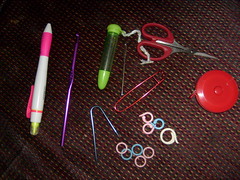While I was yarn shopping with Naomi on Thursday and she asked me what she needed besides needles and yarn, it got me thinking: what are the truly essential items that should never leave your knitting bag? What is just nice to have? Are some notions a waste of money?
So I made a list and took a picture of what is in my notions bag, which has all my essentials plus a few nice-to-have items.
 Essentials:Scissors
Essentials:Scissors. Just because the phrase "break yarn" is common knitting jargon doesn't mean you have to actually break it. My scissors are small embroidery snippers. Anything that cuts yarn will do, from scissors of all sizes to pendants that have protected blades. Those are nice for getting thorugh airport security.
Darning/tapestry needles for weaving in ends. I recommend a variety of sizes to accomodate a variety of yarn weights. Clover has a nice
set that comes with a screw-top case. Mine is tied to my scissors.
Measuring tape. A regular ribbon-style tape is fine, but having a little retractable one is better when you don't want a three foot long measuring tape uncoiled and causing chaos in your notions bag.
You can get by on having just those, but I strongly recommend also having these:
Stitch markers. These come in handy for lots of things. I carry both ring and split-ring markers. Even if you don't need to keep a marker on for a pattern, casting on lots (50+) of stitches usually means counting to see how many you've done so far. Put a marker after a certain number of stitches and you don't have to count as much. Plain plastic and fancy beaded will perform the same function, so getting fancy markers is purely a matter of personal preference.
Pen/pencil. Making notations on patterns is great. Writing down your gauge on a yarn's ball band is better. I also like to keep track of row counts/pattern repeats with hash marks.
Crochet hook. Even the most experienced knitters drop stitches now and again. You can technically do it with a knitting needle, but it's a pain in the rear, especially if the stitch has dropped several rows. Hooking up the ladder makes a frustrating process a little easier.
I'd say those are the things you should really have. Now the extras.
Nice to Have:
Stitch holders. Many projects have times where you need to keep stitches live. You can have holders that are designed for this purpose or you can use a spare needle or other object that will work just fine. I like to use either holders or a double pointed need with point protectors at the ends.
Cable needles. Cables are fun. Like with stitch holders, you can use something other than a needle designed for this specific purpose, like a double pointed needle. You can also learn how to cable without using anything to hold those stitches.
Point protectors. You can stick some on the ends of dpns to use them as straight needles, cap your needles to keep your work from falling off, or cap both ends of a single dpn to use it as a stitch holder. The possibilites are vast.
Safety pins. Not only are these good to have all the time, they are extremely useful for knitting. They can be stitch or row markers, hold together edges of pieces for fitting or seaming, anything you can think of. If you can find them, get the ones with no coil because those can snag yarn. Come to think of it, safety pins could easily go under "essentials."
Bobbins. If you dabble in intarsia or other colorwork that requires you to work with several small amounts of yarn simultaneously, bobbins are nice. You can make little center-pull bundles that make bobbins unnecessary, but until one has mastered that, plastic or heavy cardboard bobbins are the ticket.
Graph paper. Sometimes you want to chart out written instructions or make your own design. Maybe you just want something to write on. Regular paper is fine for that, but because a knitted item is composed of a grid of stitches, graph paper is handy.
In my opinion, everything else is optional. Sure, some people might not be able to live without their Norwegian knitting thimble, but I doubt the majority of us need one. Having a needle sizer, a metal/plastic plate with holes of specific sizes, is nice for some things, but most of us use one so infrequently that we just use a friend's. On top of notions that are optional, there are the fancy versions of the basics: stitch holders that look more like jewelry, decorative tip protectors, bags that have various pockets and zippered compartments.
The sky is the limit when it comes to knitting accessories. Start with the basics, then start personalizing. A knitter's notions bag often reflects his or her personality. Practical but fun? Utilitarian and efficient? Colorful and pretty? As with all things knitting, the variety of notions available turns our art into expression and adds to the enjoyment we feel as we knit.










